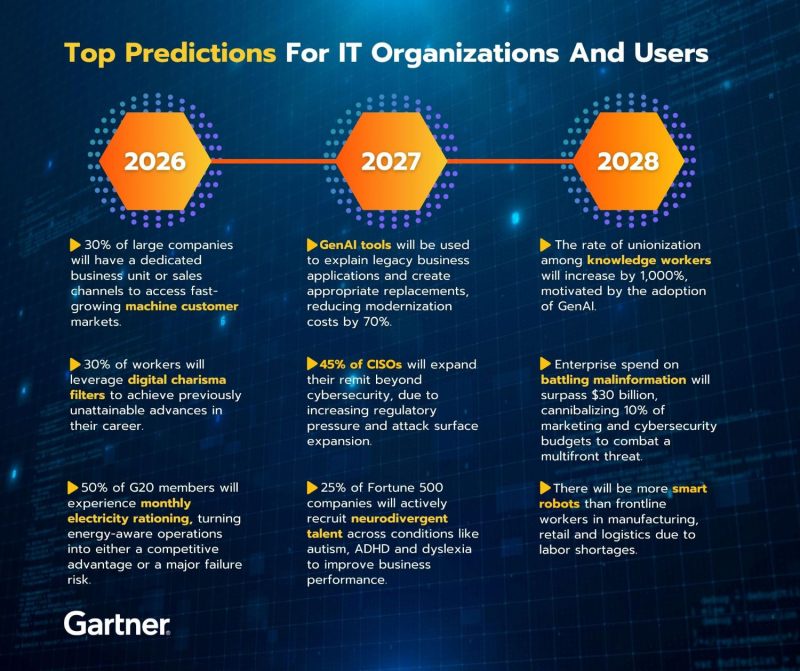"GenAI presents an opportunity to accomplish things never before possible in the scope of human existence," said Daryl Plummer, Distinguished VP Analyst at Gartner. "CIOs and executive leaders will embrace the risks of using GenAI so they can reap the unprecedented benefits.
"This is the first full year with GenAI at the heart of every strategic decision, and every other technology-driven innovation has been pushed out of the spotlight. GenAI has broken the mold and has kept building more excitement."
By 2027, the productivity value of AI will be recognized as a primary economic indicator of national power.
National governments have a strong commitment to AI and are prioritizing strategies and plans that recognize AI as a key technology in both private and public sectors. Incorporating AI into long-term national planning is being reinforced through the implementation of corresponding acts and regulations to bolster AI initiatives.
"Implementation at a national level will solidify AI as a catalyst for enhancing productivity to boost the digital economy," said Plummer. "Successful implementation of large-scale AI initiatives necessitates the support and collaboration of diverse stakeholders, showcasing the mobilization and convening ability of national resources."
By 2027, GenAI tools will be used to explain legacy business applications and create appropriate replacements, reducing modernization costs by 70%.
"The maturity of large language models (LLMs) offers an opportunity for CIOs to find credible and long-awaited mechanism for modernizing legacy business applications in a cost-effective manner," said Plummer. "CIOs can create dedicated testing units to test the output generated by GenAI LLMs, while establishing change management and upskilling processes to enable the workforce to maximize productivity throughout the modernization cycle."
By 2028, enterprise spend on battling malinformation will surpass $30 billion, cannibalizing 10% of marketing and cybersecurity budgets to combat a multifront threat.
The most effective malinformation influences humans' and machines' decision-making mechanisms and can be extremely hard to detect and shut down. Malinformation presents threats across three disparate functional areas: cybersecurity, marketing and AI.
"The rapid rise of GenAI has put fire under the feet of regulators about including malinformation as one of the risks associated with the increasing power and availability of GenAI to bad actors," said Plummer. "Enterprises who maintain a close watch on bad actors, regulators and providers of tools and technology that help combat malinformation are likely to gain significant advantage over competitors."
By 2027, 45% of chief information security officers (CISOs) will expand their remit beyond cybersecurity, due to increasing regulatory pressure and attack surface expansion.
Responsibilities for security management and digital assets are fragmented across multiple divisions and teams, with the CISO overseeing the overall digital asset portfolio. This creates inconsistencies in support for regulatory disclosures, assurance of digital security and effective management of security incidents, reducing the overall performance of the organization.
Expanding the portfolio of the CISO will enable a unification of security management, providing oversight of the consolidated security incident management process throughout the organization.
By 2028, the rate of unionization among knowledge workers will increase by 1,000%, motivated by the adoption of GenAI.
Executives are quick to call out AI as a cause of positions being eliminated. Therefore, it is important for executive leaders to communicate clearly with their employees their intent for internal AI deployments. This will avoid the unintended consequences of AI anxiety building among staff. Organizations that adopt GenAI and fail to clearly address AI anxiety amongst their knowledge workers will experience 20% higher rates of turnover.
"Organizations should focus their AI efforts on worker augmentation to improve productivity and quality of work, rather than role automation," said Plummer. "Stay grounded in what the technology can and cannot deliver, because there remains a substantial amount of hype influencing board expectations."
In 2026, 30% of workers will leverage digital charisma filters to achieve previously unattainable advances in their career.
A digital charisma filter prompts and sifts communications to make them more socially effective in various situations. They nudge in the moment of and before and after interactions to make leaders and co-workers more effective in the social circumstances where they wish to excel. Digital charisma filters will improve organizations' abilities to expand hiring to include more diverse workers.
"Organizations can expand their talent pool by incorporating the use of digital charisma filter assistants to improve the congruency of interactions at all phases of recruiting and employment," said Plummer. "Accelerate access to digital charisma assistants by pressing enterprise productivity and application vendors on how they are incorporating these capabilities into their roadmaps."
By 2027, 25% of Fortune 500 companies will actively recruit neurodivergent talent across conditions like autism, ADHD and dyslexia to improve business performance.
"Organizations that hire and retain neurodivergent talent will experience increased employee engagement, productivity and innovation across the workforce," said Plummer.
Fortune 500 companies are already investing in neurodiversity hiring programs and are seeing impacts on engagement and business outcomes. Organizations need to establish an outreach program to boost the discoverability of neurodiverse talent. Fast-track efforts by leveraging best practices from experts and lessons from leading organizations already working on neurodiversity.
"Include neurodivergent people in company leadership positions," said Plummer. "Having openly neurodivergent leadership fosters a culture of inclusion and can be the most valuable action to take from the perspective of neurodivergent employees."
Through 2026, 30% of large companies will have a dedicated business unit or sales channels to access fast-growing machine customer markets.
Machine customers will force a reshaping of key functions such as supply chain, sales, marketing, customer service, digital commerce and customer experience. In fact, by 2025, more than 25% of sales and service centers in large organizations will be fielding calls from machine customers.
"Machine customers will need their own sales and service channels because they make transactions at high speeds and the volume of decision variables they use far exceed human capabilities," said Plummer. "Machine customers will require different talent, skills and processes that may not exist in a human-customer focused division."
By 2028, there will be more smart robots than frontline workers in manufacturing, retail and logistics due to labor shortages.
Most manufacturing, retail and logistics companies cannot find or retain enough people to support their day-to-day operations. This will cause supply chain organizations to struggle to find enough front-line workers over the next decade. Robots will help fill this gap. A December 2022 Gartner survey found that 96% of supply chain technology workers have either deployed or plan to deploy cyber-physical automation and 35% have already deployed robots, with 61% piloting or in the middle of their first implementation.
"Robotic technology is advancing rapidly, making robots viable for a growing number of front-line jobs from the factory floor to the warehouse to the retail store and beyond," said Plummer.
By 2026, 50% of G20 members will experience monthly electricity rationing, turning energy-aware operations into either a competitive advantage or a major failure risk.
Aging grid infrastructures are limiting the ability to add electricity generating capacity, yet demand for electricity continues to increase. Enterprises are assessing energy price and accessibility as a competitiveness, which means stable access to electricity for customers will become a competitive advantage. Because of this, executive leaders are creating energy-aware operations through optimization and direct investment in energy generation.
"Leverage energy efficiency to establish long-term competitive advantage by structurally reducing energy consumptions," said Plummer. "Assess enterprise investment by including current and future anticipated costs of energy."
Source: PC & Associates Consulting

